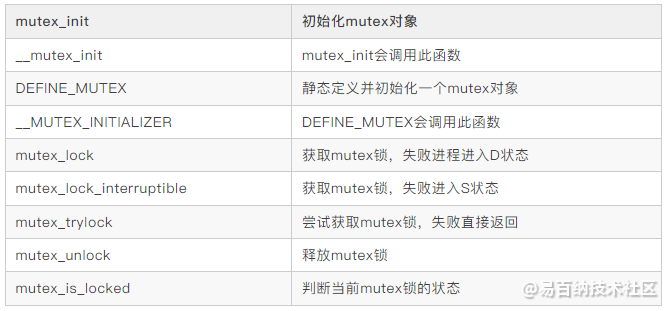Linux内核同步机制mutex
mutex锁概述
在linux内核中,互斥量mutex是一种保证CPU串行运行的睡眠锁机制。和spinlock类似,都是同一个时刻只有一个线程进入临界资源,不同的是,当无法获取锁的时候,spinlock原地自旋,而mutex则是选择挂起当前线程,进入阻塞状态。所以,mutex无法在中断上下文中使用。
mutex锁使用注意事项
- mutex一次只能有一个进程或线程持有该锁
- mutex只有它的拥有者可以释放该锁
- 不能多次释放同一把锁
- 不可以重复获取同一把锁,否则会造成死锁
- 必须使用mutex提供的专用初始化函数初始化该锁
- 不能重复初始化同一把锁
- 不能使用
memset或memcpy等内存处理函数初始化mutex锁 - 线程退出时要释放自己持有的所有mutex锁
- 不能用于设备中断或软中断上下文中
mutex锁结构体定义
- owner:记录mutex的持有者
- wait_lock:spinlock自旋锁
- soq:MCS锁队列,用于支持mutex乐观自旋机制
- wait_list:当无法获取锁的时候挂起在此
- magic:用于debug调试
- dep_map:用于debug调试
struct mutex {
atomic_long_t owner;
spinlock_t wait_lock;
#ifdef CONFIG_MUTEX_SPIN_ON_OWNER
struct optimistic_spin_queue osq; /* Spinner MCS lock */
#endif
struct list_head wait_list;
#ifdef CONFIG_DEBUG_MUTEXES
void *magic;
#endif
#ifdef CONFIG_DEBUG_LOCK_ALLOC
struct lockdep_map dep_map;
#endif
};mutex锁主要接口函数

获取锁流程分析
mutex_lock()函数调用might_sleep()函数判断锁的状态,调用__mutex_trylock_fast()函数尝试快速获取mutex锁,如果失败,则调用__mutex_lock_slowpath()函数获取mutex锁
void __sched mutex_lock(struct mutex *lock)
{
might_sleep();
if (!__mutex_trylock_fast(lock))
__mutex_lock_slowpath(lock);
}如果没有定义CONFIG_DEBUG_ATOMIC_SLEEP宏,might_sleep 函数退化为 might_resched() 函数。
# define might_sleep() \
do { __might_sleep(__FILE__, __LINE__, 0); might_resched(); } while (0)
# define sched_annotate_sleep() (current->task_state_change = 0)
#else
static inline void ___might_sleep(const char *file, int line,
int preempt_offset) { }
static inline void __might_sleep(const char *file, int line,
int preempt_offset) { }
# define might_sleep() do { might_resched(); } while (0)
# define sched_annotate_sleep() do { } while (0)在配置了抢占式内核或者非抢占式内核的情况下,might_resched() 函数最终都是空函数。如果配置了主动抢占式内核CONFIG_PREEMPT_VOLUNTARY,则might_resched()函数会调用 _cond_resched() 函数来主动触发一次抢占。
#ifdef CONFIG_PREEMPT_VOLUNTARY
extern int _cond_resched(void);
# define might_resched() _cond_resched()
#else
# define might_resched() do { } while (0)
#endif
#ifndef CONFIG_PREEMPT
extern int _cond_resched(void);
#else
static inline int _cond_resched(void) { return 0; }
#endif——cond_resched()函数调用should_resched()函数判断抢占计数器是否为0,如果抢占计数器为0并且设置了重新调度标记则调用preempt_schedule_common()函数进行抢占式调度
#ifndef CONFIG_PREEMPT
int __sched _cond_resched(void)
{
if (should_resched(0)) {
preempt_schedule_common();
return 1;
}
return 0;
}
EXPORT_SYMBOL(_cond_resched);
#endif__mutex_trylock_fast()函数调用atomic_long_cmpxchg_acquire()函数判断lock->owner的值是否等于0,如果等于0,则直接将当前线程的task struct的指针赋值给lock->owner,表示该mutex锁已经被当前线程持有。如果lock->owner的值不等于0,则表示该mutex锁已经被其他线程持有或者锁正在传递给top waiter线程,当前线程需要阻塞等待。上面描述的操作(比较和赋值)都是原子操作,不会有任何指令插入。
static __always_inline bool __mutex_trylock_fast(struct mutex *lock)
{
unsigned long curr = (unsigned long)current;
if (!atomic_long_cmpxchg_acquire(&lock->owner, 0UL, curr))
return true;
return false;
}慢速获取mutex锁的路径就是__mutex_lock_common()函数,所谓慢速其实就是阻塞当前线程,将current task挂入mutex的等待队列的尾部。让所有等待mutex的任务按照时间的先后顺序排列起来,当mutex被释放的时候,会首先唤醒队首的任务,即最先等待的任务最先被唤醒。此外,在向空队列插入第一个任务的时候,会给mutex flag设置上MUTEX_FLAG_WAITERS标记,表示已经有任务在等待这个mutex锁了。
static noinline void __sched
__mutex_lock_slowpath(struct mutex *lock)
{
__mutex_lock(lock, TASK_UNINTERRUPTIBLE, 0, NULL, _RET_IP_);
}
static int __sched
__mutex_lock(struct mutex *lock, long state, unsigned int subclass,
struct lockdep_map *nest_lock, unsigned long ip)
{
return __mutex_lock_common(lock, state, subclass, nest_lock, ip, NULL, false);
}
static __always_inline int __sched
__mutex_lock_common(struct mutex *lock, long state, unsigned int subclass,
struct lockdep_map *nest_lock, unsigned long ip,
struct ww_acquire_ctx *ww_ctx, const bool use_ww_ctx)
{
struct mutex_waiter waiter;
bool first = false;
struct ww_mutex *ww;
int ret;
might_sleep();
ww = container_of(lock, struct ww_mutex, base);
if (use_ww_ctx && ww_ctx) {
if (unlikely(ww_ctx == READ_ONCE(ww->ctx)))
return -EALREADY;
}
preempt_disable();
mutex_acquire_nest(&lock->dep_map, subclass, 0, nest_lock, ip);
if (__mutex_trylock(lock) ||
mutex_optimistic_spin(lock, ww_ctx, use_ww_ctx, NULL)) {
/* got the lock, yay! */
lock_acquired(&lock->dep_map, ip);
if (use_ww_ctx && ww_ctx)
ww_mutex_set_context_fastpath(ww, ww_ctx);
preempt_enable();
return 0;
}
spin_lock(&lock->wait_lock);
/*
* After waiting to acquire the wait_lock, try again.
*/
if (__mutex_trylock(lock)) {
if (use_ww_ctx && ww_ctx)
__ww_mutex_wakeup_for_backoff(lock, ww_ctx);
goto skip_wait;
}
debug_mutex_lock_common(lock, &waiter);
debug_mutex_add_waiter(lock, &waiter, current);
lock_contended(&lock->dep_map, ip);
if (!use_ww_ctx) {
/* add waiting tasks to the end of the waitqueue (FIFO): */
list_add_tail(&waiter.list, &lock->wait_list);
#ifdef CONFIG_DEBUG_MUTEXES
waiter.ww_ctx = MUTEX_POISON_WW_CTX;
#endif
} else {
/* Add in stamp order, waking up waiters that must back off. */
ret = __ww_mutex_add_waiter(&waiter, lock, ww_ctx);
if (ret)
goto err_early_backoff;
waiter.ww_ctx = ww_ctx;
}
waiter.task = current;
if (__mutex_waiter_is_first(lock, &waiter))
__mutex_set_flag(lock, MUTEX_FLAG_WAITERS);
set_current_state(state);
for (;;) {
/*
* Once we hold wait_lock, we're serialized against
* mutex_unlock() handing the lock off to us, do a trylock
* before testing the error conditions to make sure we pick up
* the handoff.
*/
if (__mutex_trylock(lock))
goto acquired;
/*
* Check for signals and wound conditions while holding
* wait_lock. This ensures the lock cancellation is ordered
* against mutex_unlock() and wake-ups do not go missing.
*/
if (unlikely(signal_pending_state(state, current))) {
ret = -EINTR;
goto err;
}
if (use_ww_ctx && ww_ctx && ww_ctx->acquired > 0) {
ret = __ww_mutex_lock_check_stamp(lock, &waiter, ww_ctx);
if (ret)
goto err;
}
spin_unlock(&lock->wait_lock);
schedule_preempt_disabled();
/*
* ww_mutex needs to always recheck its position since its waiter
* list is not FIFO ordered.
*/
if ((use_ww_ctx && ww_ctx) || !first) {
first = __mutex_waiter_is_first(lock, &waiter);
if (first)
__mutex_set_flag(lock, MUTEX_FLAG_HANDOFF);
}
set_current_state(state);
/*
* Here we order against unlock; we must either see it change
* state back to RUNNING and fall through the next schedule(),
* or we must see its unlock and acquire.
*/
if (__mutex_trylock(lock) ||
(first && mutex_optimistic_spin(lock, ww_ctx, use_ww_ctx, &waiter)))
break;
spin_lock(&lock->wait_lock);
}
spin_lock(&lock->wait_lock);
acquired:
__set_current_state(TASK_RUNNING);
mutex_remove_waiter(lock, &waiter, current);
if (likely(list_empty(&lock->wait_list)))
__mutex_clear_flag(lock, MUTEX_FLAGS);
debug_mutex_free_waiter(&waiter);
skip_wait:
/* got the lock - cleanup and rejoice! */
lock_acquired(&lock->dep_map, ip);
if (use_ww_ctx && ww_ctx)
ww_mutex_set_context_slowpath(ww, ww_ctx);
spin_unlock(&lock->wait_lock);
preempt_enable();
return 0;
err:
__set_current_state(TASK_RUNNING);
mutex_remove_waiter(lock, &waiter, current);
err_early_backoff:
spin_unlock(&lock->wait_lock);
debug_mutex_free_waiter(&waiter);
mutex_release(&lock->dep_map, 1, ip);
preempt_enable();
return ret;
}释放锁流程分析
释放锁的流程也分快速释放和慢速释放两种路径
void __sched mutex_unlock(struct mutex *lock)
{
#ifndef CONFIG_DEBUG_LOCK_ALLOC
if (__mutex_unlock_fast(lock))
return;
#endif
__mutex_unlock_slowpath(lock, _RET_IP_);
}如果一个线程获取了mutex锁之后,没有其他的线程试图获取,此时的mutex的owner成员就是该线程的task struct地址,并且所有的mutex flag都没有被设置。这时候只需要将mutex的owner成员清零即可,不需要其它操作,这就是快速释放锁的路径。
static __always_inline bool __mutex_unlock_fast(struct mutex *lock)
{
unsigned long curr = (unsigned long)current;
if (atomic_long_cmpxchg_release(&lock->owner, curr, 0UL) == curr)
return true;
return false;
}如果有其他线程在竞争该mutex锁,这时候就会进入慢速释放锁路径,慢速释放锁路径的逻辑分成两段:一段是释放mutex锁,另外一段是唤醒top waiter线程。
static noinline void __sched __mutex_unlock_slowpath(struct mutex *lock, unsigned long ip)
{
struct task_struct *next = NULL;
DEFINE_WAKE_Q(wake_q);
unsigned long owner;
mutex_release(&lock->dep_map, 1, ip);
/*
* Release the lock before (potentially) taking the spinlock such that
* other contenders can get on with things ASAP.
*
* Except when HANDOFF, in that case we must not clear the owner field,
* but instead set it to the top waiter.
*/
owner = atomic_long_read(&lock->owner);
for (;;) {
unsigned long old;
#ifdef CONFIG_DEBUG_MUTEXES
DEBUG_LOCKS_WARN_ON(__owner_task(owner) != current);
DEBUG_LOCKS_WARN_ON(owner & MUTEX_FLAG_PICKUP);
#endif
if (owner & MUTEX_FLAG_HANDOFF)
break;
old = atomic_long_cmpxchg_release(&lock->owner, owner,
__owner_flags(owner));
if (old == owner) {
if (owner & MUTEX_FLAG_WAITERS)
break;
return;
}
owner = old;
}
spin_lock(&lock->wait_lock);
debug_mutex_unlock(lock);
if (!list_empty(&lock->wait_list)) {
/* get the first entry from the wait-list: */
struct mutex_waiter *waiter =
list_first_entry(&lock->wait_list,
struct mutex_waiter, list);
next = waiter->task;
debug_mutex_wake_waiter(lock, waiter);
wake_q_add(&wake_q, next);
}
if (owner & MUTEX_FLAG_HANDOFF)
__mutex_handoff(lock, next);
spin_unlock(&lock->wait_lock);
wake_up_q(&wake_q);
}总结
本篇主要介绍了mutex互斥锁的使用注意事项,介绍了mutex的主要函数接口以及获取锁的流程分析和释放锁的流程分析。通过本文的学习,我们基本可以了解了mutex的实现机制和使用方法。
- 分享
- 举报
 暂无数据
暂无数据-
浏览量:9097次2020-12-09 10:16:29
-
浏览量:3754次2020-04-27 16:58:40
-
浏览量:1330次2023-08-18 14:08:55
-
浏览量:1578次2023-08-18 10:36:32
-
浏览量:6811次2018-06-21 17:58:57
-
浏览量:1460次2023-08-22 11:07:14
-
浏览量:1049次2023-08-22 17:27:47
-
浏览量:3272次2017-11-20 16:03:39
-
浏览量:1932次2023-08-11 18:18:49
-
浏览量:1943次2023-08-14 16:26:07
-
浏览量:2584次2020-08-28 15:08:37
-
浏览量:8582次2021-12-03 17:12:00
-
浏览量:2683次2024-02-05 11:02:54
-
浏览量:4542次2020-10-28 23:08:53
-
2023-06-12 14:35:55
-
浏览量:4908次2019-09-01 11:15:39
-
浏览量:4730次2022-02-11 09:00:12
-
浏览量:4258次2020-08-19 16:34:45
-
浏览量:3987次2024-01-10 10:01:45
-
广告/SPAM
-
恶意灌水
-
违规内容
-
文不对题
-
重复发帖
hury





 微信支付
微信支付举报类型
- 内容涉黄/赌/毒
- 内容侵权/抄袭
- 政治相关
- 涉嫌广告
- 侮辱谩骂
- 其他
详细说明



 微信扫码分享
微信扫码分享 QQ好友
QQ好友





